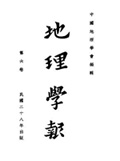WANG YI-XIAN
1. Two characteristic points of temperature fall in the cold half year of South China (S. of 25癗. lat.) have been observed: (1)The fall of temperature has been deeply affected by cold advection, more so in South China than in other parts of the country. In southern Yunnan, however, the fall may result from radiation cooling as well as from cold advection. (2) The fall of daily temperature most frequently occurs in hfarch or February and that of minimum temperature in January for South China, while the fall of both these temperatures for Central China, occurs in March and for North and Northwest China in April. 2. The main tracks of cold wave centers are more frequently between 105-115 E. long. (Kwangtung and Kwangsi) than either to the east or the west. 3. Three regions may be divided according to the intensity of temperature fall: (i) region of strong fall in Kwangtung and Kwangsi, (ii) region of moderate fall in Fukien, (iii) region of slight fall in southern Yunnan.
